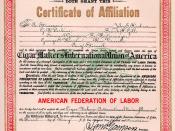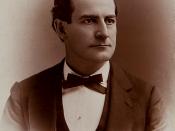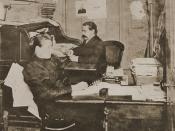In the decades after the Civil War, an "Engine of Change" spread across America (LN 9/11). This engine had five chief causes: government assistance, availability of resources, human capital, foreign capital, and technology. From the second Industrial Revolution to World War I, America witnessed a period of reaction that shaped the twentieth century. The Engine of Change affected the worlds of industrial work, politics, law, and foreign relations.
The Engine of Change saw the rise and spread of Big Business throughout the United States. In 1860, a majority of people did not have jobs industrial in nature, but retained skilled trades such as men's clothing and shoes (LN 9/11). This would soon change over the next few decades as Big Business transformed the labor force. The first Big Business was the railroad industry (R 39). The national railroad system provided transportation for the nations goods with the completion of the transcontinental railroad.
The federal government provided capital and funds to spur railroad growth. This resulted in a double win for the government as the nation gained interstate transportation, and the government sold the surrounding land on either side of the tracks for profit (TS 681).
Interstate transportation was just one new innovation during this period. A sundry of new inventions were introduced like electric power, the telegraph, and telephone which resulted in increased communication across the country (TS 677). New machinery was in use to increase efficiency and output. However, not all advancements were made in technology. The railroad industry is responsible for the managerial system in use in many companies today. With the Pennsylvania Railroad setting the tone for organization, the system of "low cost, high volume" operations was put in place (R 45). As the railroads expanded, they lacked effective management and organization. The Pennsylvania Railroad developed a...



Nice
The body part was very imformative and could be just what many people would ask for The only thing i didn't like about this essay is the introduction. It feels kinda strange when I read it, but the rest are fine.
2 out of 2 people found this comment useful.